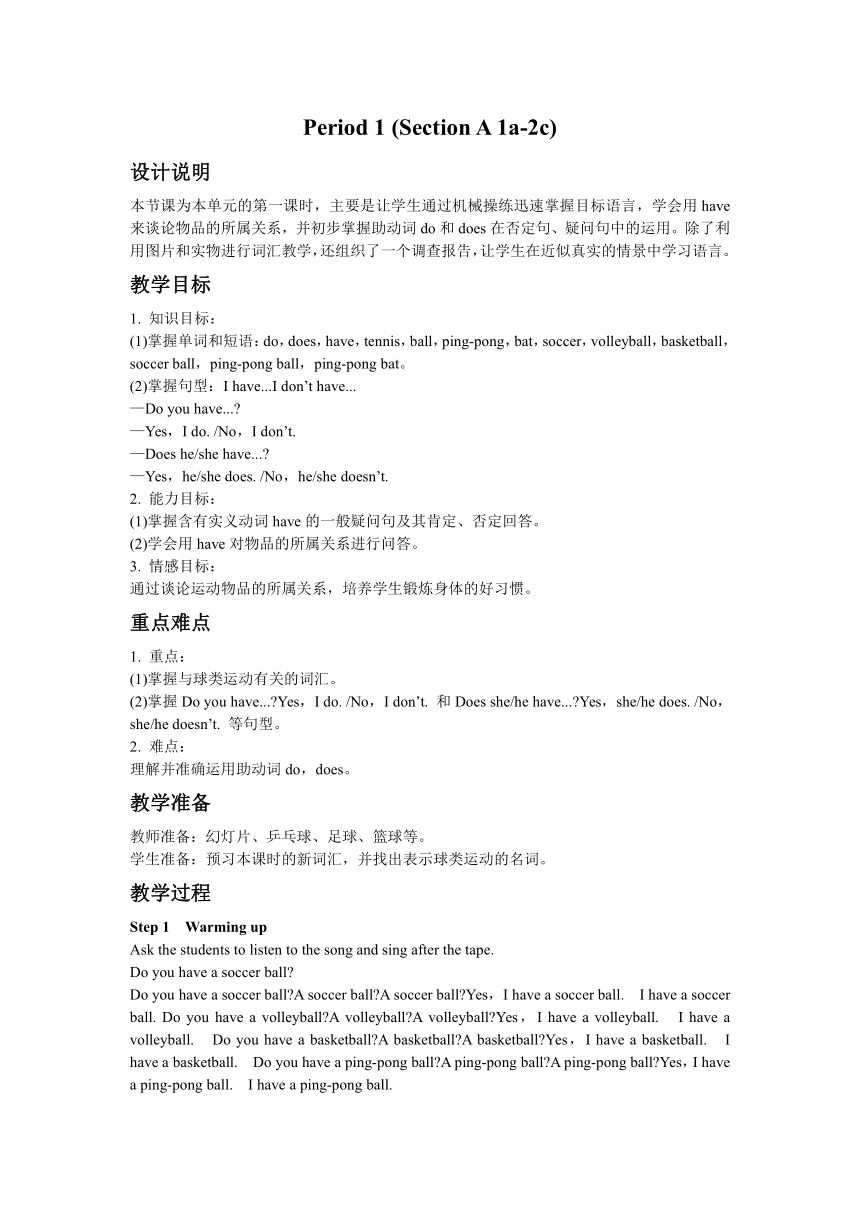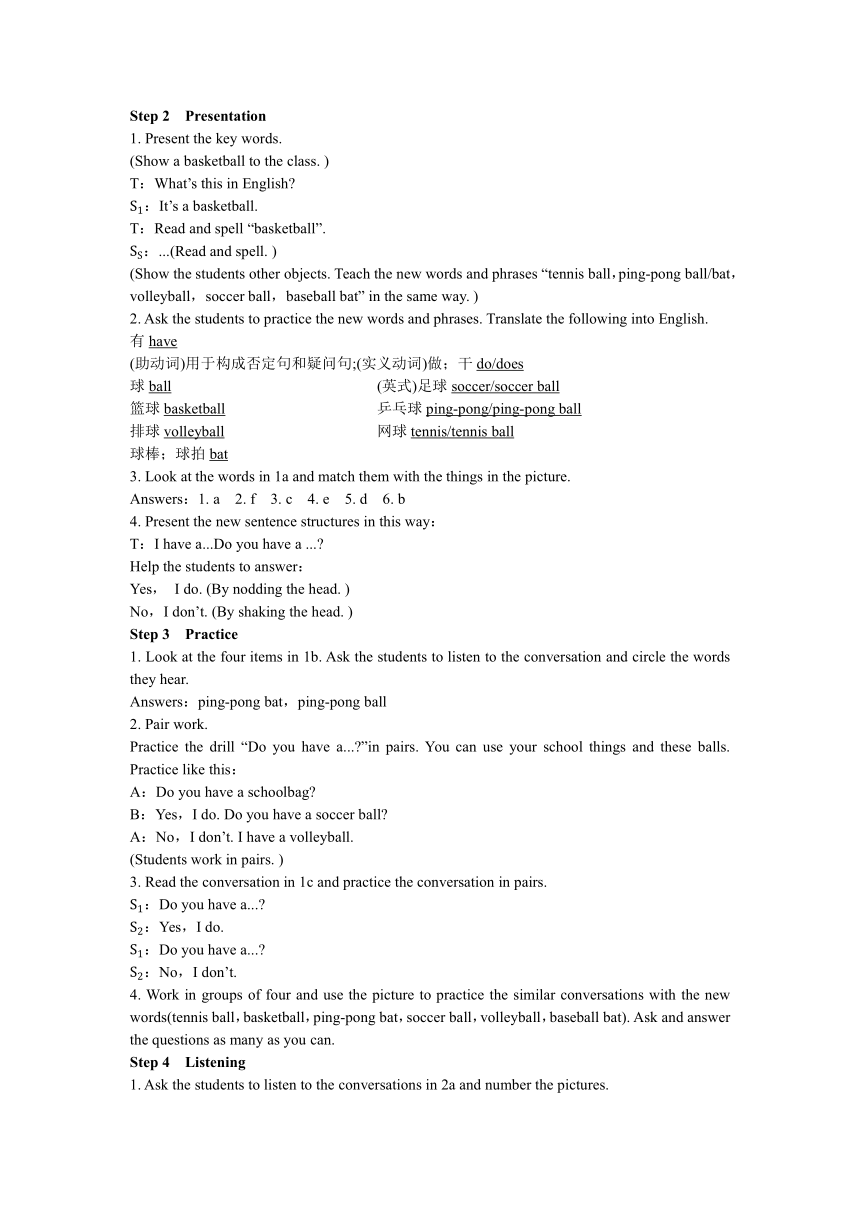人教版七年级上册SUnit 5 Do you have a soccer ball?Section A (1a-2c)教案
文档属性
| 名称 | 人教版七年级上册SUnit 5 Do you have a soccer ball?Section A (1a-2c)教案 |  | |
| 格式 | docx | ||
| 文件大小 | 62.6KB | ||
| 资源类型 | 教案 | ||
| 版本资源 | 人教新目标(Go for it)版 | ||
| 科目 | 英语 | ||
| 更新时间 | 2022-07-07 15:15:48 | ||
图片预览


文档简介
Period 1 (Section A 1a-2c)
设计说明
本节课为本单元的第一课时,主要是让学生通过机械操练迅速掌握目标语言,学会用have来谈论物品的所属关系,并初步掌握助动词do和does在否定句、疑问句中的运用。除了利用图片和实物进行词汇教学,还组织了一个调查报告,让学生在近似真实的情景中学习语言。
教学目标
1. 知识目标:
(1)掌握单词和短语:do,does,have,tennis,ball,ping-pong,bat,soccer,volleyball,basketball,soccer ball,ping-pong ball,ping-pong bat。
(2)掌握句型:I have...I don’t have...
—Do you have...
—Yes,I do. /No,I don’t.
—Does he/she have...
—Yes,he/she does. /No,he/she doesn’t.
2. 能力目标:
(1)掌握含有实义动词have的一般疑问句及其肯定、否定回答。
(2)学会用have对物品的所属关系进行问答。
3. 情感目标:
通过谈论运动物品的所属关系,培养学生锻炼身体的好习惯。
重点难点
1. 重点:
(1)掌握与球类运动有关的词汇。
(2)掌握Do you have... Yes,I do. /No,I don’t. 和Does she/he have... Yes,she/he does. /No,she/he doesn’t. 等句型。
2. 难点:
理解并准确运用助动词do,does。
教学准备
教师准备:幻灯片、乒乓球、足球、篮球等。
学生准备:预习本课时的新词汇,并找出表示球类运动的名词。
教学过程
Step 1 Warming up
Ask the students to listen to the song and sing after the tape.
Do you have a soccer ball
Do you have a soccer ball A soccer ball A soccer ball Yes,I have a soccer ball. I have a soccer ball. Do you have a volleyball A volleyball A volleyball Yes,I have a volleyball. I have a volleyball. Do you have a basketball A basketball A basketball Yes,I have a basketball. I have a basketball. Do you have a ping-pong ball A ping-pong ball A ping-pong ball Yes,I have a ping-pong ball. I have a ping-pong ball.
Step 2 Presentation
1. Present the key words.
(Show a basketball to the class. )
T:What’s this in English
:It’s a basketball.
T:Read and spell “basketball”.
:...(Read and spell. )
(Show the students other objects. Teach the new words and phrases “tennis ball,ping-pong ball/bat,volleyball,soccer ball,baseball bat” in the same way. )
2. Ask the students to practice the new words and phrases. Translate the following into English.
有have
(助动词)用于构成否定句和疑问句;(实义动词)做;干do/does
球ball (英式)足球soccer/soccer ball
篮球basketball 乒乓球ping-pong/ping-pong ball
排球volleyball 网球tennis/tennis ball
球棒;球拍bat
3. Look at the words in 1a and match them with the things in the picture.
Answers:1. a 2. f 3. c 4. e 5. d 6. b
4. Present the new sentence structures in this way:
T:I have a...Do you have a ...
Help the students to answer:
Yes, I do. (By nodding the head. )
No,I don’t. (By shaking the head. )
Step 3 Practice
1. Look at the four items in 1b. Ask the students to listen to the conversation and circle the words they hear.
Answers:ping-pong bat,ping-pong ball
2. Pair work.
Practice the drill “Do you have a... ”in pairs. You can use your school things and these balls. Practice like this:
A:Do you have a schoolbag
B:Yes,I do. Do you have a soccer ball
A:No,I don’t. I have a volleyball.
(Students work in pairs. )
3. Read the conversation in 1c and practice the conversation in pairs.
:Do you have a...
:Yes,I do.
:Do you have a...
:No,I don’t.
4. Work in groups of four and use the picture to practice the similar conversations with the new words(tennis ball,basketball,ping-pong bat,soccer ball,volleyball,baseball bat). Ask and answer the questions as many as you can.
Step 4 Listening
1. Ask the students to listen to the conversations in 2a and number the pictures.
(Remind the students of the key information. )Then check the answers.
Answers:(From left to right)3,4,1,2
2. Look at the pictures in 2b and name them.
What are these
(Point at the tennis ball,basketball,soccer ball and volleyball. )
3. Listen again. Match the people from Activity 2a with the balls in 2b. Then check the answers.
Answers:(From left to right)3,2,1,4
Step 5 Group work
1. Ask the students to talk about the people in 2a & 2b like that in 2c.
2. Ask the students to make a survey about the balls they have and don’t have. Then write down the information in the chart.
names have not have
3. Make a report:
Choose one student from each group to report about their work. Like this:
I have a...I don’t have a...
Tom has a...He doesn’t have a...
4. Work in groups.
(1)“Do you have... ”是一般现在时的一般疑问句,其中have是一个实义动词。句子的谓语动词如果是实义动词,常借助于助动词do或does构成一般疑问句,主语是第三人称单数时用does,其他人称作主语时用do。其基本句式为“Do/Does+主语+动词原形+...?”其肯定答语为“Yes,主语+do/does. ”,否定答语为“No,主语+don’t/doesn’t. ”。
(2)have是及物动词,意为“拥有”,有人称和数的变化,其第三人称单数形式是has。常用句式为“某人/某物+have/has+某物”,表示“某人/某物有某物”。
(3)实义动词(如have/has)作谓语时,其否定形式也要借助于助动词do或does来完成。do/does通常要和not缩写为don’t/doesn’t,助动词do/does后面的谓语动词要用原形。
I don’t have(没有) a pen.
He doesn’t have(没有) a pencil.
Step 6 Summary
In this lesson,we have learned:
1. New words and a phrase:have,do,does,ball,soccer,tennis,ping-pong,volleyball,basketball,bat,soccer ball.
2. Sentences:
I have a...I don’t have a...
—Do you have ...
—Yes,I do. /No,I don’t.
He/She has a...
He/She doesn’t have a...
—Does he/she have...
—Yes,he/she does. /No,he/she doesn’t.
当堂达标(见导学案“当堂达标”)
答案与解析:
Ⅰ. 1. soccer 2. volleyball 3. basketballs 4. tennis
Ⅱ. 1. D 问句为含有实义动词have的一般疑问句,助动词用do,答语也应用助动词do;问句主语为第二人称,回答时应用第一人称,选D。
2. B 问句中your sister为第三人称单数,助动词应用does,否定回答用doesn’t。
3. C 主语his brother为第三人称单数;表示某人“有”,应用have,此处用have的第三人称单数形式has,选C。
4. B 主语she为第三人称单数,一般现在时中需借助助动词does构成否定句。助动词do/does后应用动词原形,选B。
Ⅲ. 1. Do,have 2. Does,play 3. doesn’t have 4. Does;does 5. has
Step 7 Homework
1. Make a survey about your partners’ favorite sports and their sports collections and give a report.
2. Preview work:
Role-play the conversation in 2d.
板书设计
教学反思
设计说明
本节课为本单元的第一课时,主要是让学生通过机械操练迅速掌握目标语言,学会用have来谈论物品的所属关系,并初步掌握助动词do和does在否定句、疑问句中的运用。除了利用图片和实物进行词汇教学,还组织了一个调查报告,让学生在近似真实的情景中学习语言。
教学目标
1. 知识目标:
(1)掌握单词和短语:do,does,have,tennis,ball,ping-pong,bat,soccer,volleyball,basketball,soccer ball,ping-pong ball,ping-pong bat。
(2)掌握句型:I have...I don’t have...
—Do you have...
—Yes,I do. /No,I don’t.
—Does he/she have...
—Yes,he/she does. /No,he/she doesn’t.
2. 能力目标:
(1)掌握含有实义动词have的一般疑问句及其肯定、否定回答。
(2)学会用have对物品的所属关系进行问答。
3. 情感目标:
通过谈论运动物品的所属关系,培养学生锻炼身体的好习惯。
重点难点
1. 重点:
(1)掌握与球类运动有关的词汇。
(2)掌握Do you have... Yes,I do. /No,I don’t. 和Does she/he have... Yes,she/he does. /No,she/he doesn’t. 等句型。
2. 难点:
理解并准确运用助动词do,does。
教学准备
教师准备:幻灯片、乒乓球、足球、篮球等。
学生准备:预习本课时的新词汇,并找出表示球类运动的名词。
教学过程
Step 1 Warming up
Ask the students to listen to the song and sing after the tape.
Do you have a soccer ball
Do you have a soccer ball A soccer ball A soccer ball Yes,I have a soccer ball. I have a soccer ball. Do you have a volleyball A volleyball A volleyball Yes,I have a volleyball. I have a volleyball. Do you have a basketball A basketball A basketball Yes,I have a basketball. I have a basketball. Do you have a ping-pong ball A ping-pong ball A ping-pong ball Yes,I have a ping-pong ball. I have a ping-pong ball.
Step 2 Presentation
1. Present the key words.
(Show a basketball to the class. )
T:What’s this in English
:It’s a basketball.
T:Read and spell “basketball”.
:...(Read and spell. )
(Show the students other objects. Teach the new words and phrases “tennis ball,ping-pong ball/bat,volleyball,soccer ball,baseball bat” in the same way. )
2. Ask the students to practice the new words and phrases. Translate the following into English.
有have
(助动词)用于构成否定句和疑问句;(实义动词)做;干do/does
球ball (英式)足球soccer/soccer ball
篮球basketball 乒乓球ping-pong/ping-pong ball
排球volleyball 网球tennis/tennis ball
球棒;球拍bat
3. Look at the words in 1a and match them with the things in the picture.
Answers:1. a 2. f 3. c 4. e 5. d 6. b
4. Present the new sentence structures in this way:
T:I have a...Do you have a ...
Help the students to answer:
Yes, I do. (By nodding the head. )
No,I don’t. (By shaking the head. )
Step 3 Practice
1. Look at the four items in 1b. Ask the students to listen to the conversation and circle the words they hear.
Answers:ping-pong bat,ping-pong ball
2. Pair work.
Practice the drill “Do you have a... ”in pairs. You can use your school things and these balls. Practice like this:
A:Do you have a schoolbag
B:Yes,I do. Do you have a soccer ball
A:No,I don’t. I have a volleyball.
(Students work in pairs. )
3. Read the conversation in 1c and practice the conversation in pairs.
:Do you have a...
:Yes,I do.
:Do you have a...
:No,I don’t.
4. Work in groups of four and use the picture to practice the similar conversations with the new words(tennis ball,basketball,ping-pong bat,soccer ball,volleyball,baseball bat). Ask and answer the questions as many as you can.
Step 4 Listening
1. Ask the students to listen to the conversations in 2a and number the pictures.
(Remind the students of the key information. )Then check the answers.
Answers:(From left to right)3,4,1,2
2. Look at the pictures in 2b and name them.
What are these
(Point at the tennis ball,basketball,soccer ball and volleyball. )
3. Listen again. Match the people from Activity 2a with the balls in 2b. Then check the answers.
Answers:(From left to right)3,2,1,4
Step 5 Group work
1. Ask the students to talk about the people in 2a & 2b like that in 2c.
2. Ask the students to make a survey about the balls they have and don’t have. Then write down the information in the chart.
names have not have
3. Make a report:
Choose one student from each group to report about their work. Like this:
I have a...I don’t have a...
Tom has a...He doesn’t have a...
4. Work in groups.
(1)“Do you have... ”是一般现在时的一般疑问句,其中have是一个实义动词。句子的谓语动词如果是实义动词,常借助于助动词do或does构成一般疑问句,主语是第三人称单数时用does,其他人称作主语时用do。其基本句式为“Do/Does+主语+动词原形+...?”其肯定答语为“Yes,主语+do/does. ”,否定答语为“No,主语+don’t/doesn’t. ”。
(2)have是及物动词,意为“拥有”,有人称和数的变化,其第三人称单数形式是has。常用句式为“某人/某物+have/has+某物”,表示“某人/某物有某物”。
(3)实义动词(如have/has)作谓语时,其否定形式也要借助于助动词do或does来完成。do/does通常要和not缩写为don’t/doesn’t,助动词do/does后面的谓语动词要用原形。
I don’t have(没有) a pen.
He doesn’t have(没有) a pencil.
Step 6 Summary
In this lesson,we have learned:
1. New words and a phrase:have,do,does,ball,soccer,tennis,ping-pong,volleyball,basketball,bat,soccer ball.
2. Sentences:
I have a...I don’t have a...
—Do you have ...
—Yes,I do. /No,I don’t.
He/She has a...
He/She doesn’t have a...
—Does he/she have...
—Yes,he/she does. /No,he/she doesn’t.
当堂达标(见导学案“当堂达标”)
答案与解析:
Ⅰ. 1. soccer 2. volleyball 3. basketballs 4. tennis
Ⅱ. 1. D 问句为含有实义动词have的一般疑问句,助动词用do,答语也应用助动词do;问句主语为第二人称,回答时应用第一人称,选D。
2. B 问句中your sister为第三人称单数,助动词应用does,否定回答用doesn’t。
3. C 主语his brother为第三人称单数;表示某人“有”,应用have,此处用have的第三人称单数形式has,选C。
4. B 主语she为第三人称单数,一般现在时中需借助助动词does构成否定句。助动词do/does后应用动词原形,选B。
Ⅲ. 1. Do,have 2. Does,play 3. doesn’t have 4. Does;does 5. has
Step 7 Homework
1. Make a survey about your partners’ favorite sports and their sports collections and give a report.
2. Preview work:
Role-play the conversation in 2d.
板书设计
教学反思
同课章节目录
- starters 预备篇(2012秋审查)
- Unit 1 Good morning !
- Unit 2 What’s this in English?
- Unit 3 What color is it ?
- Unit 1 My name's Gina.
- Section A
- Section B
- Unit 2 This is my sister.
- Section A
- Section B
- Unit 3 Is this your pencil?
- Section A
- Section B
- Unit 4 Where's my schoolbag?
- Section A
- Section B
- Unit 5 Do you have a soccer ball?
- Section A
- Section B
- Unit 6 Do you like bananas?
- Section A
- Section B
- Unit 7 How much are these socks?
- Section A
- Section B
- Unit 8 When is your birthday?
- Section A
- Section B
- Unit 9 My favorite subject is science.
- Section A
- Section B
